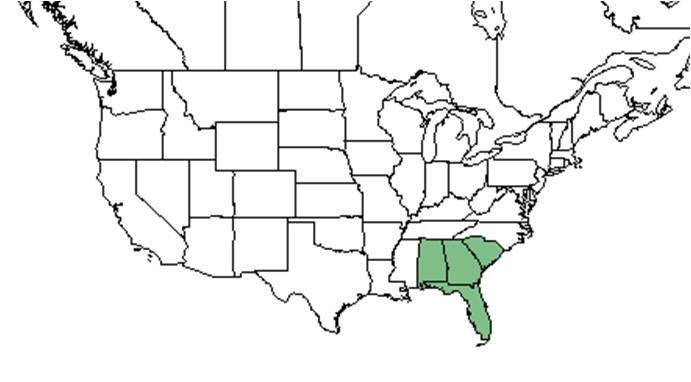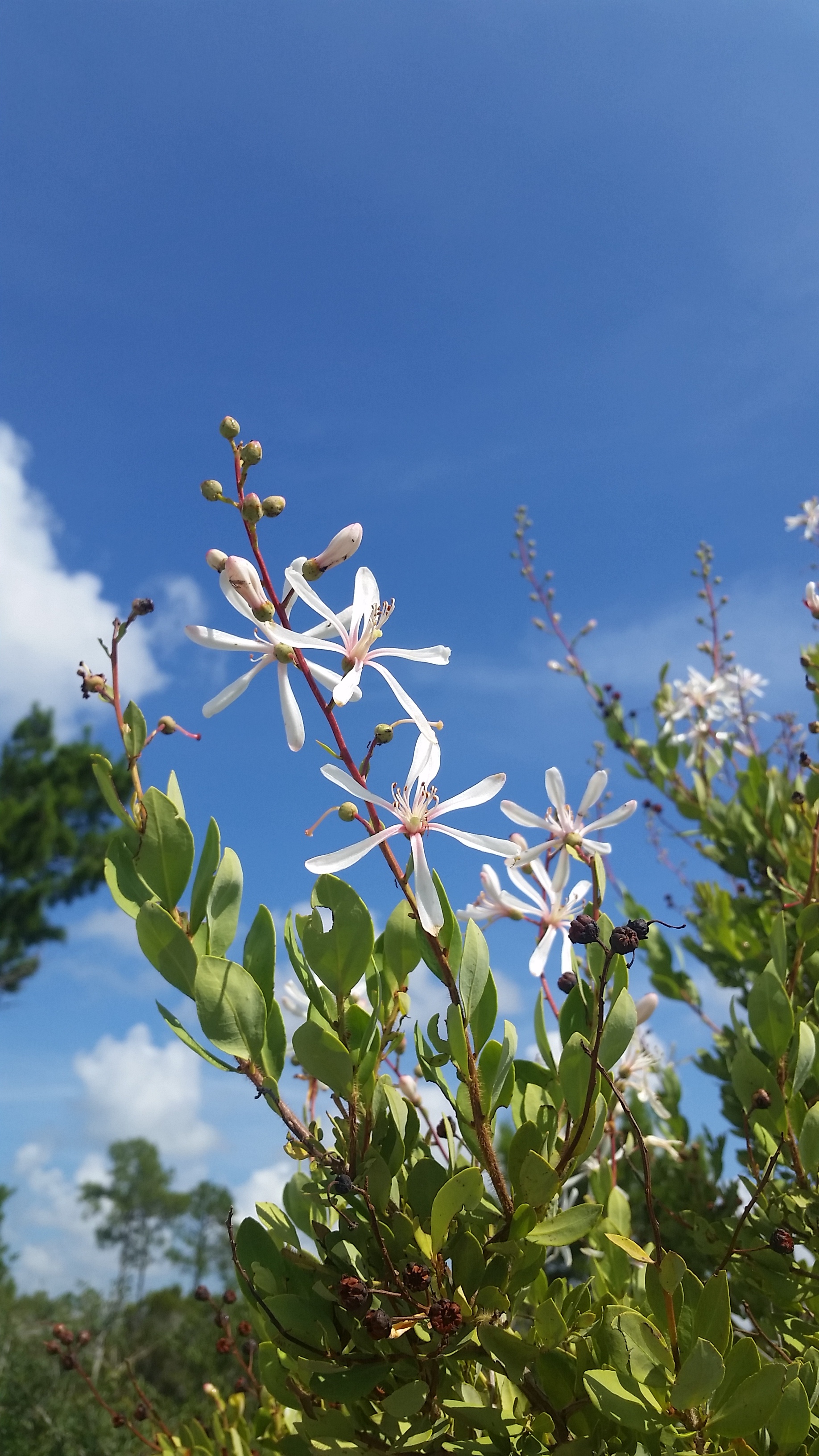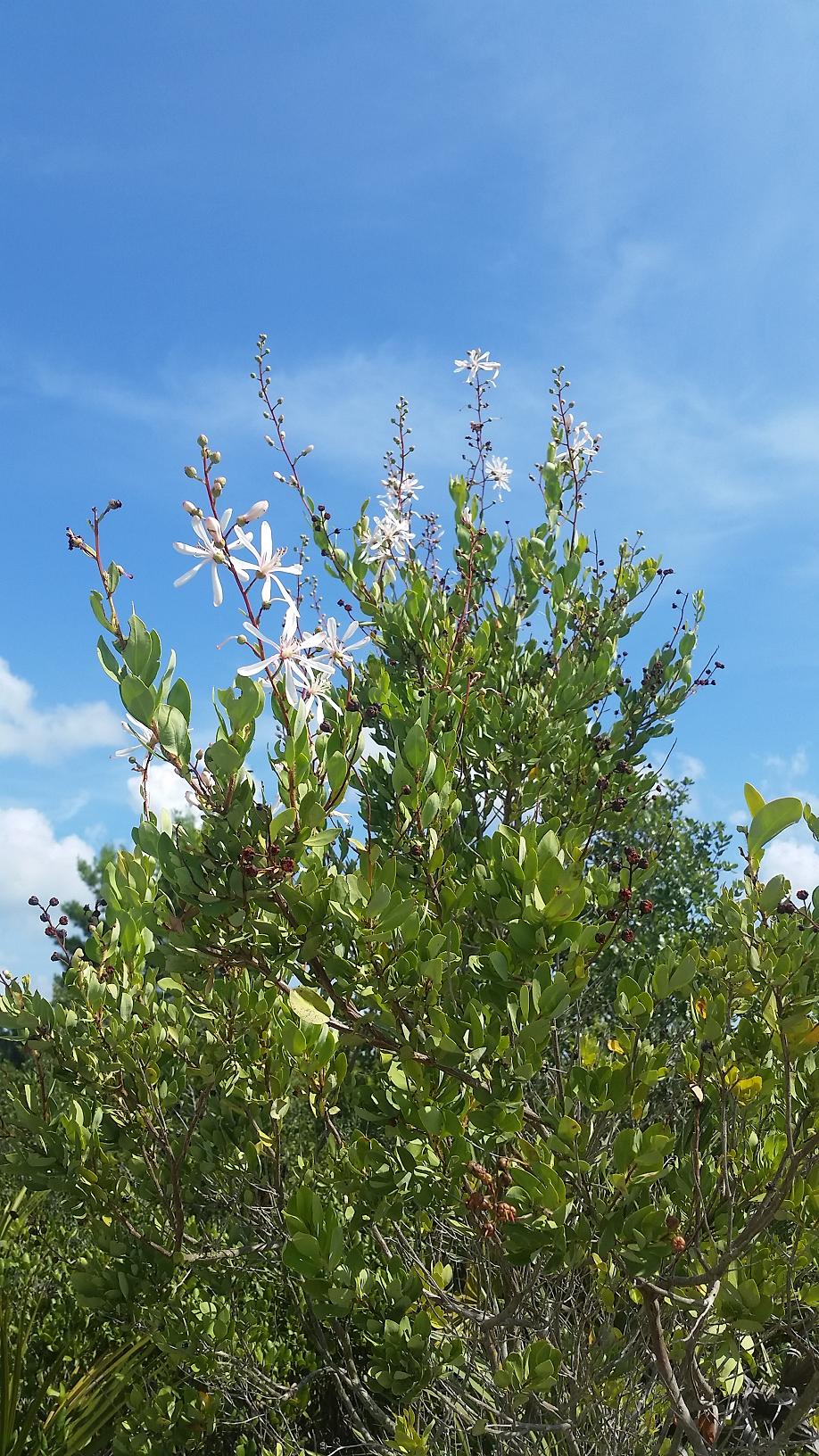Difference between revisions of "Bejaria racemosa"
KatieMccoy (talk | contribs) (→References and notes) |
HaleighJoM (talk | contribs) (→Ecology) |
||
| (35 intermediate revisions by 8 users not shown) | |||
| Line 17: | Line 17: | ||
| range_map_caption = Natural range of ''Bejaria racemosa'' from USDA NRCS [http://plants.usda.gov/core/profile?symbol=BERA3 Plants Database]. | | range_map_caption = Natural range of ''Bejaria racemosa'' from USDA NRCS [http://plants.usda.gov/core/profile?symbol=BERA3 Plants Database]. | ||
}} | }} | ||
| − | Common | + | Common names: Flyweed, Tarflower, Flycatcher |
==Taxonomic notes== | ==Taxonomic notes== | ||
| + | Synonyms: ''Befaria racemosa'' Vent.<ref name="weakley">Weakley, A.S. 2015. Flora of the southern and mid-atlantic states. Working Draft of 21 May 2015. University of North Carolina at Chapel Hill, Chapel Hill, North Carolina.</ref> | ||
| + | |||
| + | Varieties: none.<ref name="weakley">Weakley, A.S. 2015. Flora of the southern and mid-atlantic states. Working Draft of 21 May 2015. University of North Carolina at Chapel Hill, Chapel Hill, North Carolina.</ref> | ||
| + | |||
==Description== | ==Description== | ||
<!-- Basic life history facts such as annual/perrenial, monoecious/dioecious, root morphology, seed type, etc. --> | <!-- Basic life history facts such as annual/perrenial, monoecious/dioecious, root morphology, seed type, etc. --> | ||
A description of ''Bejaria racemosa'' is provided in [http://www.efloras.org/florataxon.aspx?flora_id=1&taxon_id=250015286 The Flora of North America]. | A description of ''Bejaria racemosa'' is provided in [http://www.efloras.org/florataxon.aspx?flora_id=1&taxon_id=250015286 The Flora of North America]. | ||
| + | |||
| + | Species in the genus ''Bejaria'' have separate petals, radial symmetry, open rotate flowers, superior ovaries, and septicidal capsules; classifying them as the most primitive genus in ''Ericaceae.''<ref>Kron, Kathleen A.. Phylogenetic Relationships of Rhododendroideae (Ericaceae). American Journal of Botany 84.7 (1997): 973–980.</ref> | ||
| + | |||
| + | Specifically, ''B. racemosa'' is a long-living perennial shrub with leaves that are alternate, entire and coriaceous (leathery). The leaves and stems are covered with rough, firm, stiff hairs.<ref name="IFAS Extension">[[http://lee.ifas.ufl.edu/Hort/GardenPubsAZ/Tarflower.pdf IFAS Extension]] Accessed: December 2, 2015</ref> The plant grows around 2 - 5 feet high and has large white flowers tinged pink. A viscid sticky substance that entraps insects is secreted on the stem below the flower.<ref>Webster, G. W.. Insectivorous Plants of South Florida. Science 22.546 (1893): 37–38.</ref> | ||
==Distribution== | ==Distribution== | ||
| + | It is a native to southeast Georgia and throughout Florida, except in the western panhandle and the keys.<ref name="IFAS">[[http://lee.ifas.ufl.edu/Hort/GardenPubsAZ/Tarflower.pdf IFAS Extension]] Accessed: December 2, 2015</ref> | ||
| + | |||
==Ecology== | ==Ecology== | ||
===Habitat=== <!--Natural communities, human disturbed habitats, topography, hydrology, soils, light, fire regime requirements for removal of competition, etc.--> | ===Habitat=== <!--Natural communities, human disturbed habitats, topography, hydrology, soils, light, fire regime requirements for removal of competition, etc.--> | ||
| − | In the Coastal Plain in Florida, ''B. racemosa'' has been found in pine flatwoods, scrub barrens, and sand pine scrubs | + | In the Coastal Plain in Florida, ''B. racemosa'' has been found in pine flatwoods, scrub barrens, and sand pine scrubs.<ref name="FSU">Florida State University Robert K. Godfrey Herbarium database. URL: [http://herbarium.bio.fsu.edu http://herbarium.bio.fsu.edu]. Last accessed: October 2015. Collectors: Michael B. Brooks, R.K. Godfrey, R. Kral, Sidney McDaniel, Jean W. Wooten. States and Counties: Florida: Dixie, Highlands, Palm Beach, St. Johns. Compiled by Tall Timbers Research Station and Land Conservancy.</ref> It is drought tolerant and is found on well drained sandy soils in full sun to light shade.<ref name="natives">[[http://regionalconservation.org/beta/nfyn/plantdetail.asp?tx=Bejarace Natives for your neighborhood]] Accessed: December 2, 2015.</ref> |
| + | |||
| + | Associated species include ''[[Callicarpa americana]], Ceratiola ericoides, [[Rhus copallinum]]'', slash pine, wax myrtle, and saw palmetto.<ref name="IFAS"/> | ||
| − | ===Phenology=== <!--Timing off flowering, fruiting | + | ===Phenology=== <!--Timing off flowering, fruiting, and environmental triggers. Cite PanFlora website if appropriate: http://www.gilnelson.com/PanFlora/ --> |
| − | It has been observed flowering and fruiting May through August | + | Flowers are white with a pink tinge with black, sticky dehiscent fruit.<ref name="IFAS"/><ref name=FNPS>[[http://www.fnps.org/plants/plant/bejaria-racemosa Florida Native Plant Society]]Accessed December 2, 2015</ref> It has been observed flowering and fruiting May through August.<ref name="FSU"></ref><ref>Nelson, G. [http://www.gilnelson.com/ PanFlora]: Plant data for the eastern United States with emphasis on the Southeastern Coastal Plains, Florida, and the Florida Panhandle. www.gilnelson.com/PanFlora/ Accessed: 19 MAY 2021</ref> |
| + | <!--===Seed dispersal===--> | ||
| − | |||
===Seed bank and germination=== | ===Seed bank and germination=== | ||
| − | ===Fire ecology=== <!--Fire tolerance, fire dependence, adaptive fire responses--> | + | For some species native to fire-prone habitats, chemicals in smoke may induce germination, signaling the seed that the environmental conditions are favorable for germination and growth<ref name="Menges">Lindon, H. L. and E. Menges (2008). "Scientific note: effects of smoke on seed germination of twenty species of fire-prone habitats in Florida." Castanea 73: 106-110.</ref>. In a study done by Lindon and Menges (2008), they found that smoke exposure under five minutes did not effect the germination rate, however there was no germination for seeds exposed to smoke for more than five minutes.<ref name="Menges"></ref> |
| + | |||
| + | <!--===Fire ecology===--> <!--Fire tolerance, fire dependence, adaptive fire responses--> | ||
| + | |||
===Pollination=== | ===Pollination=== | ||
| − | The following Hymenoptera families and species were observed visiting flowers of ''Bejaria racemosa'' at Archbold Biological Station | + | The following Hymenoptera families and species were observed visiting flowers of ''Bejaria racemosa'' at Archbold Biological Station:<ref>Deyrup, M.A. 2015. Database of observations of Hymenoptera visitations to flowers of plants on Archbold Biological Station, Florida, USA.</ref> |
Apidae: ''Apis mellifera, Bombus impatiens, B. pennsylvanicus'' | Apidae: ''Apis mellifera, Bombus impatiens, B. pennsylvanicus'' | ||
| Line 45: | Line 60: | ||
Vespidae: ''Euodynerus boscii boharti, Monobia quadridens, Parancistrocerus histrio, P. salcularis rufulus, Pseudodynerus quadrisectus, Stenodynerus fundatiformis, Zethus spinipes'' | Vespidae: ''Euodynerus boscii boharti, Monobia quadridens, Parancistrocerus histrio, P. salcularis rufulus, Pseudodynerus quadrisectus, Stenodynerus fundatiformis, Zethus spinipes'' | ||
| − | === | + | <!--===Herbivory and toxicology===--> |
| − | ===Diseases and parasites=== | + | <!--===Diseases and parasites===--> |
| − | ==Conservation and | + | |
| − | == | + | ==Conservation, cultivation, and restoration== |
| + | |||
| + | ==Cultural use== | ||
==Photo Gallery== | ==Photo Gallery== | ||
<gallery widths=180px> | <gallery widths=180px> | ||
File:Bejaria racemosa1_MSmith.jpg| <center> ''Bejaria racemosa'' <p> Photo by Michelle Smith </p><p> Archbold Biological Station, FL. | File:Bejaria racemosa1_MSmith.jpg| <center> ''Bejaria racemosa'' <p> Photo by Michelle Smith </p><p> Archbold Biological Station, FL. | ||
| − | |||
| − | |||
| − | |||
File:Bejaria racemosa3_MSmith.jpg| <center> ''Bejaria racemosa'' <p> Photo by Michelle Smith </p><p> Archbold Biological Station, FL. | File:Bejaria racemosa3_MSmith.jpg| <center> ''Bejaria racemosa'' <p> Photo by Michelle Smith </p><p> Archbold Biological Station, FL. | ||
</nowiki></gallery> | </nowiki></gallery> | ||
| − | |||
==References and notes== | ==References and notes== | ||
| − | |||
| − | |||
| − | |||
Latest revision as of 19:55, 15 June 2022
| Bejaria racemosa | |
|---|---|

| |
| Photo taken by Michelle Smith at Archbold Biological Station | |
| Scientific classification | |
| Kingdom: | Plantae |
| Division: | Magnoliophyta - Flowering plants |
| Class: | Magnoliopsida - Dicotyledons |
| Order: | Ericales |
| Family: | Ericaceae |
| Genus: | Bejaria |
| Species: | B. racemosa |
| Binomial name | |
| Bejaria racemosa Vent. | |

| |
| Natural range of Bejaria racemosa from USDA NRCS Plants Database. | |
Common names: Flyweed, Tarflower, Flycatcher
Contents
Taxonomic notes
Synonyms: Befaria racemosa Vent.[1]
Varieties: none.[1]
Description
A description of Bejaria racemosa is provided in The Flora of North America.
Species in the genus Bejaria have separate petals, radial symmetry, open rotate flowers, superior ovaries, and septicidal capsules; classifying them as the most primitive genus in Ericaceae.[2]
Specifically, B. racemosa is a long-living perennial shrub with leaves that are alternate, entire and coriaceous (leathery). The leaves and stems are covered with rough, firm, stiff hairs.[3] The plant grows around 2 - 5 feet high and has large white flowers tinged pink. A viscid sticky substance that entraps insects is secreted on the stem below the flower.[4]
Distribution
It is a native to southeast Georgia and throughout Florida, except in the western panhandle and the keys.[5]
Ecology
Habitat
In the Coastal Plain in Florida, B. racemosa has been found in pine flatwoods, scrub barrens, and sand pine scrubs.[6] It is drought tolerant and is found on well drained sandy soils in full sun to light shade.[7]
Associated species include Callicarpa americana, Ceratiola ericoides, Rhus copallinum, slash pine, wax myrtle, and saw palmetto.[5]
Phenology
Flowers are white with a pink tinge with black, sticky dehiscent fruit.[5][8] It has been observed flowering and fruiting May through August.[6][9]
Seed bank and germination
For some species native to fire-prone habitats, chemicals in smoke may induce germination, signaling the seed that the environmental conditions are favorable for germination and growth[10]. In a study done by Lindon and Menges (2008), they found that smoke exposure under five minutes did not effect the germination rate, however there was no germination for seeds exposed to smoke for more than five minutes.[10]
Pollination
The following Hymenoptera families and species were observed visiting flowers of Bejaria racemosa at Archbold Biological Station:[11]
Apidae: Apis mellifera, Bombus impatiens, B. pennsylvanicus
Halictidae: Agapostemon splendens, Augochlorella aurata, A. gratiosa, Augochloropsis sumptuosa
Megachilidae: Anthidiellum perplexum, Anthidium maculifrons, Coelioxys sayi, Megachile brevis pseudobrevis, M. mendica, M. petulans
Vespidae: Euodynerus boscii boharti, Monobia quadridens, Parancistrocerus histrio, P. salcularis rufulus, Pseudodynerus quadrisectus, Stenodynerus fundatiformis, Zethus spinipes
Conservation, cultivation, and restoration
Cultural use
Photo Gallery
References and notes
- ↑ 1.0 1.1 Weakley, A.S. 2015. Flora of the southern and mid-atlantic states. Working Draft of 21 May 2015. University of North Carolina at Chapel Hill, Chapel Hill, North Carolina.
- ↑ Kron, Kathleen A.. Phylogenetic Relationships of Rhododendroideae (Ericaceae). American Journal of Botany 84.7 (1997): 973–980.
- ↑ [IFAS Extension] Accessed: December 2, 2015
- ↑ Webster, G. W.. Insectivorous Plants of South Florida. Science 22.546 (1893): 37–38.
- ↑ 5.0 5.1 5.2 [IFAS Extension] Accessed: December 2, 2015
- ↑ 6.0 6.1 Florida State University Robert K. Godfrey Herbarium database. URL: http://herbarium.bio.fsu.edu. Last accessed: October 2015. Collectors: Michael B. Brooks, R.K. Godfrey, R. Kral, Sidney McDaniel, Jean W. Wooten. States and Counties: Florida: Dixie, Highlands, Palm Beach, St. Johns. Compiled by Tall Timbers Research Station and Land Conservancy.
- ↑ [Natives for your neighborhood] Accessed: December 2, 2015.
- ↑ [Florida Native Plant Society]Accessed December 2, 2015
- ↑ Nelson, G. PanFlora: Plant data for the eastern United States with emphasis on the Southeastern Coastal Plains, Florida, and the Florida Panhandle. www.gilnelson.com/PanFlora/ Accessed: 19 MAY 2021
- ↑ 10.0 10.1 Lindon, H. L. and E. Menges (2008). "Scientific note: effects of smoke on seed germination of twenty species of fire-prone habitats in Florida." Castanea 73: 106-110.
- ↑ Deyrup, M.A. 2015. Database of observations of Hymenoptera visitations to flowers of plants on Archbold Biological Station, Florida, USA.

